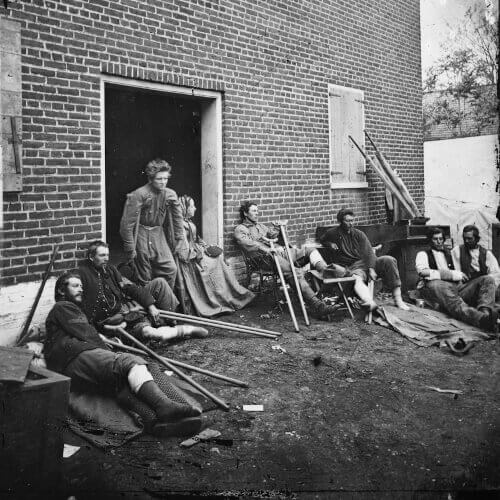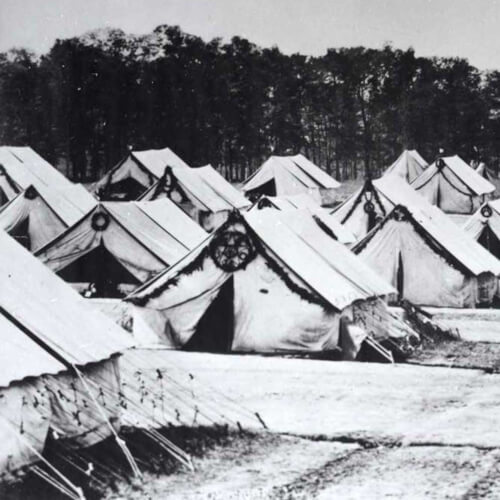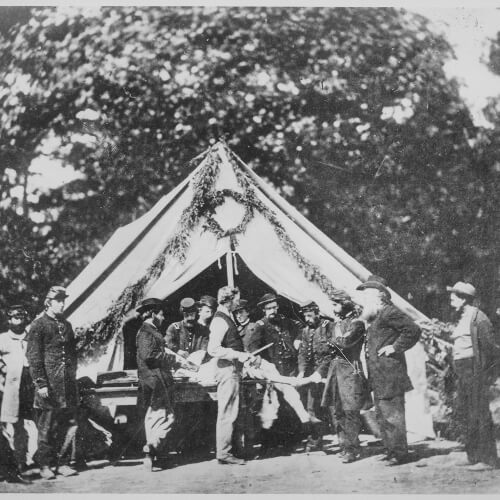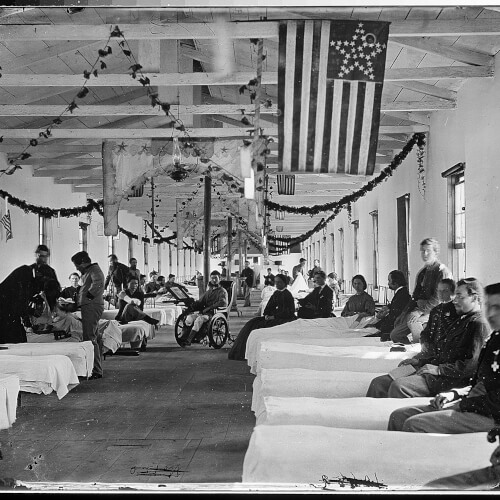Civil War Medicine
Exploring the medical practices and personnel during the Civil WarCivil War Hospitals
Over the course of the Civil War, an estimated 620,000 soldiers on both sides died. Of those deaths, about two-thirds of them were due to disease. From poor sanitation to infections from gunshot wounds, soldiers suffered from many different diseases. One advancement that came out of the Civil War was a vastly improved hospital system. At the outbreak of the war, the largest military hospital was located by Fort Leavenworth and Washington DC had only one.
Prior to the Civil War
Before the Civil War, the US army comprised approximately 16,000 soldiers and only 113 Army doctors. America’s hospitals and the Army’s Medical Department were ill-equipped to handle the impending flood of casualties at the outbreak of war. Due in part to new technological advances and tactics, such as the rifled musket and Minie Ball, resulted in staggering casualties and army surgeons were caught off guard.
During the first battle of Bull Run on July 16, 1861, there were nearly 5,000 casualties. Every available structure from homes, barns, and churches all quickly became hospitals. Unfortunately, due to the lack of preparation for these casualties, there was no organized medical treatment for the wounded. There was also no ambulance system so many wounded soldiers spent days on the field.
Sweeping Changes
As a direct result of the vast number of casualties in the field, changes began to be implemented. The Surgeon General of the Union Army Alexander Hammond and Dr. Jonathan Letterman worked tirelessly to improve hospital conditions. In addition to establishing a better ambulance system, they also improved sanitation, upgraded field hospitals, and provided training and better personnel.
Hammond and Letterman worked together to design and create large pavilion-style hospitals that were clean and well ventilated and could hold nearly 3,000 patients each. These hospitals had “wards” for different types of wounds or diseases. Hammond also instituted mandatory training in public health, hygiene, and surgery for all Union Army medical officers.
Field Hospitals
As battles raged, Army doctors would take over whatever building was available including homes, barns, schools, and churches to use as a hospital. Field hospitals were located on the battlefield, often within a mile of the front lines. These field hospitals were identified with a yellow flag that had a large green “H”.
Once a wounded soldier was treated at a field hospital, he would then have been transported to a general hospital via a train or hospital ship. These trains and ships could hold large numbers of wounded. Ships that transported soldiers to general hospitals could also serve as floating hospitals. Union ships traveled up and down the eastern coast picking up wounded soldiers and transporting them to hospitals in Washington, Philadelphia, and New York.
Growth of Civil War Hospitals
By the end of the war, there were over 200 general hospitals in the North with approximately 135,000 beds. During the war, it is estimated that over one million soldiers received care in Union military hospitals. The Union Army operated 16 medical departments, the top two by bed capacity being Washington DC and Pennsylvania. Philadelphia alone had more than 14,000 beds and its two largest general hospitals, Satterlee and Mower had 4,000 and 3,000 beds, respectively.
More on Civil War Hospitals
Confederate Hospitals
In the Confederacy, the largest general hospital was Chimborazo, which was in Richmond, Virginia. Chimborazo was built out of wood and was located on Chimborazo Hill. Approximately 78,000 patients suffering from battlefield wounds and diseases were treated here. Of these, approximately 6,500 to 8,000 died, resulting in a mortality rate of about 9 percent. In addition to patient wards, Chimborazo also had bake houses, kitchens, ice houses, stables, a guard house, a chapel, a bathhouse, and other buildings to support and care for the wounded and sick.
More Changes by Letterman
In addition to his other changes, Letterman introduced a standard medical kit for each doctor. These kits were all equipped with the same instruments and arranged in the same fashion in order to facilitate trained and use. He created a new wagon that was designed to hold medical supplies and allow for the treatment of the wounded. Similar to the medical kits, all of the wagons were arranged in the same manner. In 1862, Letterman established the ambulance corps along with a system for evacuating soldiers from the battlefield. Wounded soldiers would first be taken to a field dressing station where the wounded were initially tended to and wounds dressed. From there they were moved to a field hospital, where a doctor would address the condition and perform the appropriate treatment. Finally, ambulances would transport patients to a large hospital far from the battlefield for long-term treatment.
Anesthesia
Anesthesia was first used in 1846 and was frequently used during operations throughout the Civil War. There are some estimates that it was used over 800,000 times in treating soldiers. The most common type of anesthesia was Chloroform which was used in most operations. Chloroform was usually administered by placing some on a cloth which was then held over the patient’s mouth and nose. Once the patient was unconscious, the cloth would be removed.
Walt Whitman Describes a Battlefield Hospital
Walt Whitman, the renowned American poet, visited hospitals in and around Washington DC during the Civil War. His experiences led him to publish several works about these hospitals and the war. These Civil War-inspired works include the famed “Oh Captain! My Captain” as well as the poetry collection Drum-Taps and published prose Specimen Days.
Learn More
Videos
Vocabulary
Ambulance – a vehicle specially equipped for taking sick or injured people to and from the hospital
Amputation – the action of surgically cutting off a limb.
Anesthesia – insensitivity to pain, especially as artificially induced by the administration of gases or the injection of drugs before surgical operations.
Hospital – an institution providing medical and surgical treatment and nursing care for sick or injured people.
Pavilion –any of a number of separate or attached buildings forming a hospital or the like.
Sanitation – conditions relating to public health, especially the provision of clean drinking water and adequate sewage disposal.
Stretcher – a framework of two poles with a long piece of canvas slung between them, used for carrying sick, injured, or dead people
Surgeon – a medical practitioner qualified to practice surgery.
Ward – a separate room in a hospital, typically one allocated to a particular type of patient.




